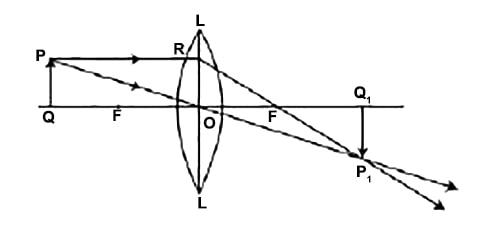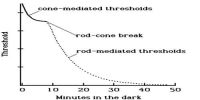We have known earlier that there is a convex lens just behind the pupil of the eye which is called eye lens. It is necessary to change the focal length of eye lens to see the distant as well as near objects.

Fig: Function of an Eye in terms of Lens
In the figure, the eye lens is shown. In front of the eye i.e. in front of the lens, PQ is an object. A ray of light PR coming from P parallel to the principal axis incidents at R and is refracted through the principal focus F along the path RFP1. Another ray PO coming from P passes through the optical center O and is refracted along the path OP1. The refracted rays RP’ and OP1 meet at point P1. From point P1 a perpendicular P1Q is drawn on the principal axis. So, P1Q1 is the real and inverted image of PQ. Where the image is formed is known as the retina. It consists of some light-sensitive cells or nerve-fibers called rods and cones.
When image or light falls on retina a kind of stimulation is created in the nerve-fibers and as a result, a sensation of vision is created in the brain and we can see the object. It is mentionable that the inverted image of an object is formed on the retina. This sensation is transmitted to the brain by the eye nerves. The brain then and there inverts the inverted image formed in the retina and we can see the object in its right shape and size.













